The city of Granada, Nicaragua, situated on the shores of the mesmerizing Lake Nicaragua, offers a captivating blend of timeless beauty, colonial heritage, and vibrant culture. Known as one of Central America’s most important cities, Granada is often referred to as the “Great Sultan” due to its Moorish namesake in Spain. The city’s enchanting past is visible in its Spanish colonial architecture, brightly colored houses, and majestic churches, all of which are nestled among lush vegetation and stunning landscapes.
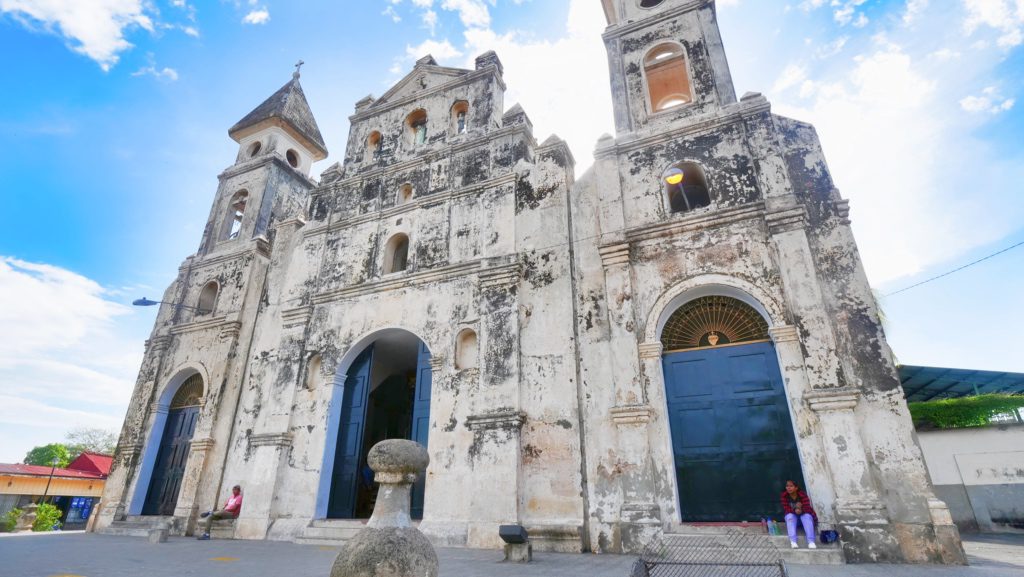
Each cobblestone street in Granada is a gateway to a rich history, a testament to the city’s resilience and charm. This is a place where you can traverse centuries just by turning a corner. From the echoing bells of the ancient cathedrals to the bustling marketplace filled with local artisans’ crafts, Granada is a sensory feast.

I visited this beautiful colonial city, and the nearby cities of Masaya and Masatepe back in the spring of 2022. Along with my guide, Carlos from Visita Nicaragua, I explored the bustling markets, stunning architecture, vibrant culture of these cities, along with the warmth of the Nicaraguan people. These are the top things you must experience in Granada, Nicaragua!
I’ve often said if you want to experience local life in any destination, visit a local market. In the Central Market in Granada, Nicaragua, you’ll find countless vendors and an array of authentic local street foods. Local frito, or fried pork or pork rinds, is a must!
You’ll also find massive whole chicharrones and chancho con yuca (made with marinated pork, yucca, and cabbage). The tortillas rellenos stuffed with rice and meat are also savory and filling! For a more unique offering try the pinol de iguana, a corn stew containing iguana meat, onions, and egg. You’ll also find spice and produce vendors, as well as those selling home goods and clothing!
Another phenomenal way to experience Granada, Nicaragua is by horse-drawn carriage! I went on a spontaneous carriage tour that took me around this beautiful colonial city. We started by passing historical homes and seeing Pedro Joaquin Guardia Chamoro Plaza and the Park of Galteba.
We continued past the Monument of Ruben Dario, dedicated to a renowned Nicaraguan poet. In the Xalteva area, our carriage driver showed us Calteba Church, which dates back to 1731. It’s a fascinating historical tour and only costs 350 Cordoba, or about $10 USD!
You don’t have to go to the Central Market to experience great street food in Granada, Nicaragua. At Central Park, I highly recommend trying vigorón, a popular local dish made with cassava, yucca, cabbage, and fried pork. Add some pickled chilies and wash it down with some coyolito, a refreshing drink similar to grape or cherry juice.
You may also find vendors selling traditional sweets like coyolito candies and candied papaya. If you’re looking for artisanal beers, visit Nectar Bar & Restaurante, where you can also sample the national drink, macuá. Elsewhere are vendors selling everything from gallo pinto to fried cheese to fresh plantain chips!
If you’re staying at Hotel Real La Merced in Granada, Nicaragua, there’s a luxurious pampering experience waiting for you right across the street! There, you’ll find a barber shop that offers one of the most amazing self-care experiences I’ve ever had in Latin America.
My barber, Asiyadora, gave me a refreshing neck, face, and head shave, along with a mud mask to tighten my skin. But the highlight of my experience was the massage, where Asiyadora used a machine to knead my head, face, neck, arms, chest, and hands. I felt rejuvenated afterward! Best of all, the entire experience only costs 500 cordobas ($14 USD), a fraction of what I’d pay for just a haircut in my hometown of Miami!

Elsewhere, you can find fantastic local spas where you can enjoy manicures, pedicures, and foot massages. I visited one on a free night in Granada, Nicaragua, and the women there were fantastic. They soaked and exfoliated my feet, clipped and buffed my toenails, gave me a manicure, and even massaged my feet, all for 500 cordobas, or $14 USD!
I’ve never been a huge sweets person, but when they’re as tasty as the ones in Nicaragua, I make an exception! At Freddy Chavez Dulceria in Masaya, I sampled a traditional sweet called almíbar. These candied fruits are typically made during Easter week and have a sticky consistency and extremely sweet taste.
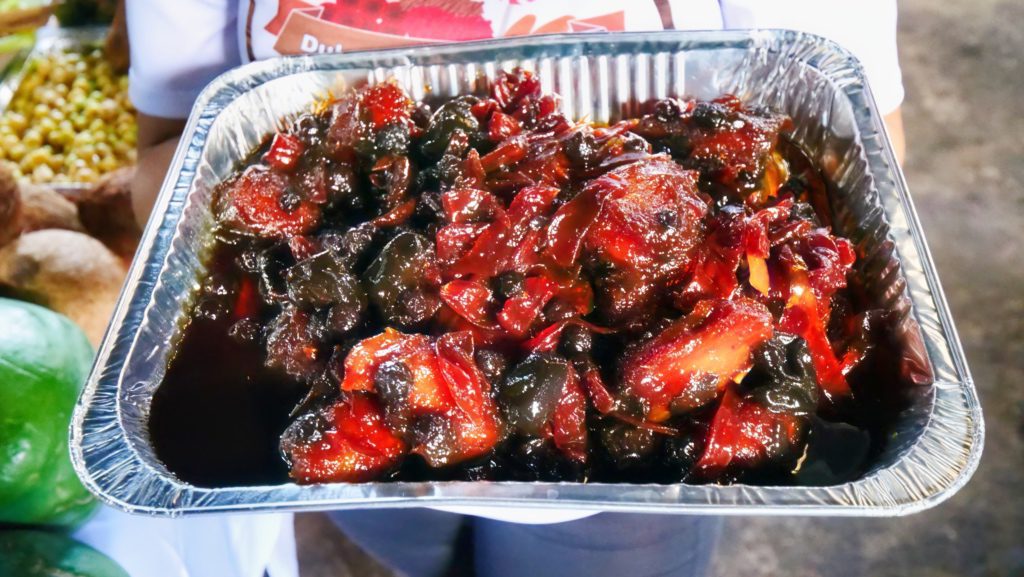
They use several different fruits, including mango, coconut, papaya, and jocote. The process involves boiling the fruit to ensure it is safe to consume and then combining it with sugar. The mixture is slow-cooked for several hours until it transforms into a thick and sugary fruit marmalade. The almíbar captures the unique flavors of each fruit and is a saccharine and surprisingly meaty treat everyone should experience!
No trip to Granada, Nicaragua is complete without visiting Masaya Market in nearby Masaya. One of the largest markets in Nicaragua, is a must-visit for those driving between Managua and Granada. There, you’ll find a variety of unique crafts, including masks, woven baskets, wooden toys, dolls, guitars, and figurines. Vendors there also sell traditional foods like rosquillas, cerdo con yuca, and chicharron.
If you’re looking for clothing, you’ll find leather sandals, dresses, jerseys, shirts, belts, wallets, and coin purses. Some of my favorite highlights were trying chicharron, morongo, and an earthy pork organ dish called chanfaina. And if you want to buy some unique souvenirs, check out the mask vendors. They sell beautifully crafted animal and traditional masks that make a great gift for friends and family!
When in the Granada, Nicaragua area, you must try one of Masaya’s most popular dishes, baho. It’s a flavorful combination of beef, yuca, sweet and green plantains, onions, tomatoes, and green peppers, steamed together in a large pot with banana leaves. I recommend trying it at Baho Vilma, a famous restaurant that specializes in this dish.
After watching the cook, Doña Vilma, prepare the dish—which looked incredible—it was time to eat. The baho came served on a banana leaf and was an explosion of flavors and textures. The meat was tender, the cabbage provided crunch, and the plantains added sweetness. The yuca contributed a starchy element to the savory-sweet combination.
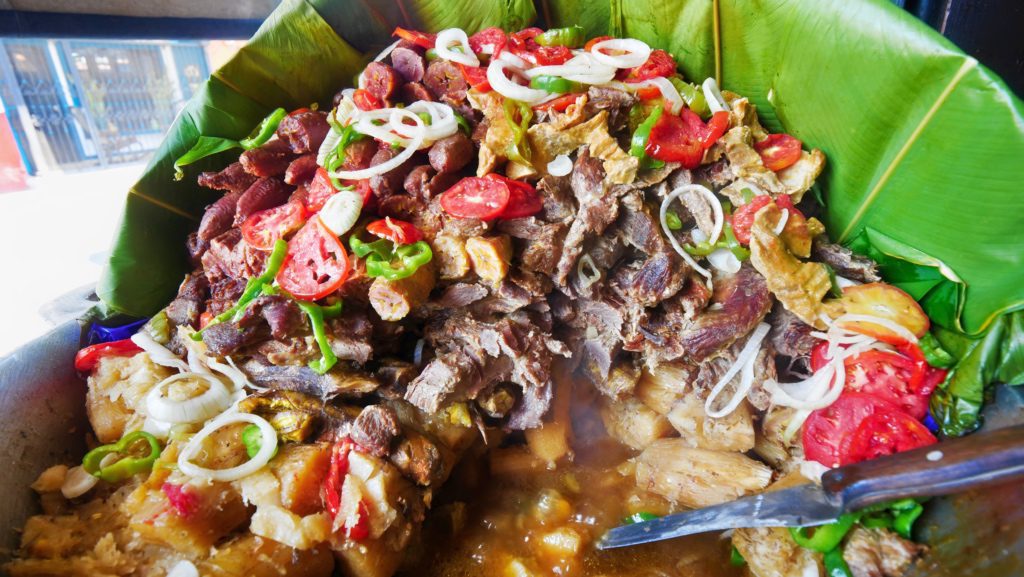
I also tried a corn-based drink with cacao called tiste, gallo pinto with tortillas and leche agria, a thin Nicaraguan yogurt. The leche agria added creaminess to the gallo pinto. If you have room, try some creamy meringue or a coconut candy called cajete de coco for dessert!
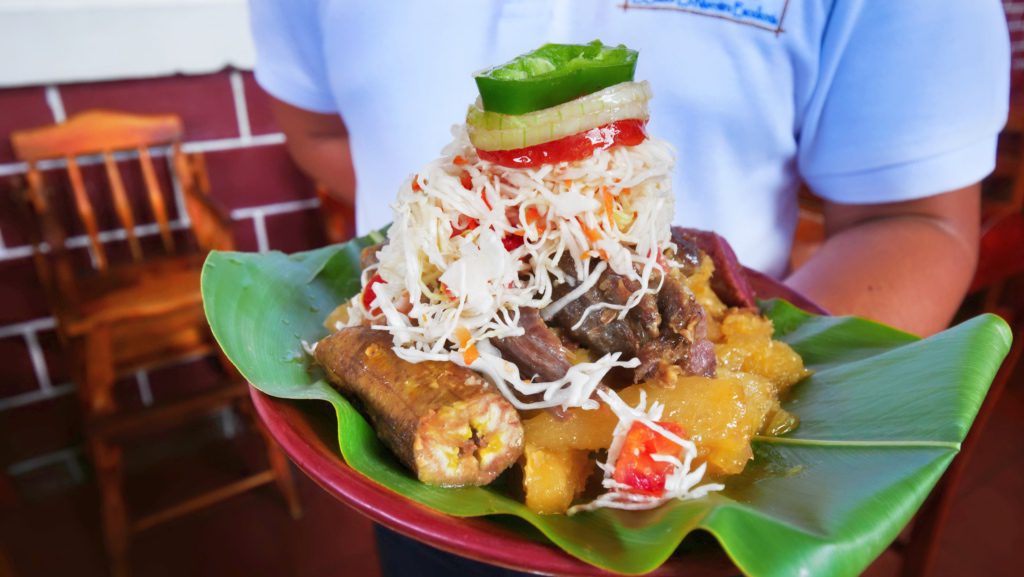
Personally, I went with both, as well as buñuelos, sweet yuca fritters topped with honey and filled with cheese!
During our visit to an exhibition hall and gift shop, we had the opportunity to witness the artistry of local mask makers. The collection showcased a diverse range of masks, including those depicting animals, skulls, and people.
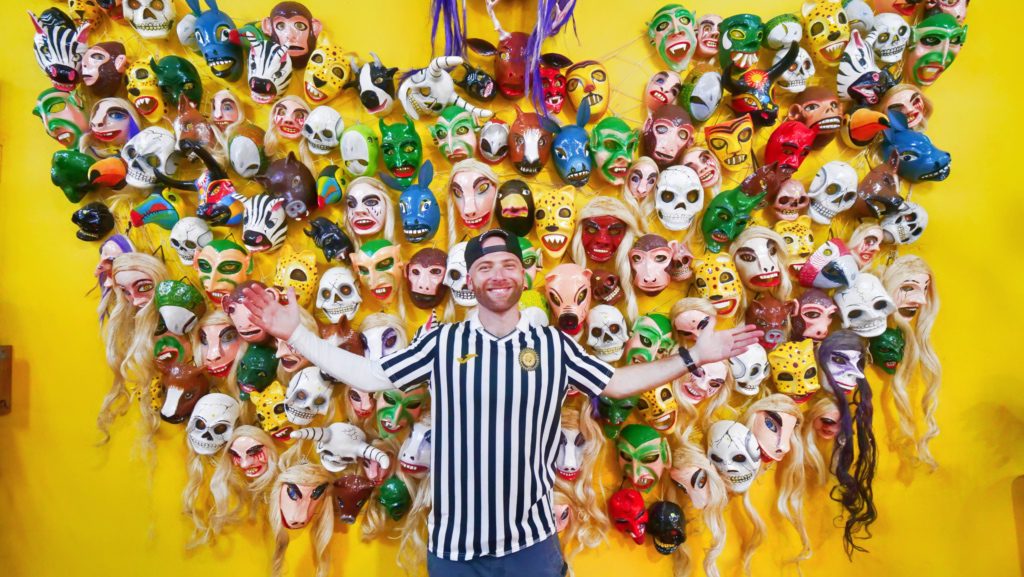
You’ll find masks made from wood and papier mache, both of which go through an intricate manufacturing process. The papier mache masks are molded and left to dry in the sun for 72 hours before being meticulously painted. I couldn’t help but appreciate the talent and dedication that goes into making the. I bought two for 800 Cordobas, or roughly $22 USD!
In nearby Masatepe, near Granada, Nicaragua, I suggest visiting El Rancho del Mondongo, a rustic, open-air restaurant that specializes in making mondongo. This local specialty is a soup containing tripe, corn, cassava, ginger, lettuce, and squash.
The tripe was spongy and delicious, with a rich earthy flavor and a hint of iron. Along with plenty of fat and vegetables, the soup also included calf ribs, cabbage, and various types of corn. On the side, we had fresh tortillas, avocado, lemon, salt, cheese, and rice. It’s a fantastic dish that you must try if you like meat, especially organ meats!
You can’t pass through Masatepe without meeting its sensational furniture makers. To meet them, I headed to Mercado de Artesanias Mazatepelth, a furniture factory in the central part of town. Here, I found a wide variety of furniture, including wicker chairs, wicker baskets, wooden tables, wooden chairs, storage ottomans, and more. The craftsmanship and beauty of the pieces were truly impressive.

At a nearby shop called Muebles Zulema, I got to see the workers sanding pieces of gorgeous carved wooden furniture. The rocking chairs immediately caught my eye with their intricate horse carvings on the sides. Each piece exuded beauty and expert craftsmanship and was a sign of the heart and soul of the people of Masatepe!
When you visit Granada, Nicaragua, be sure to explore the city, but before moving on, take some time to visit Masaya and Masatepe as well. These three unique cities provide different aspects of Nicaraguan culture and are must-visits.

From their markets to their attractions to their mouthwatering cuisine, they’re full of the types of experiences that entice curious travelers. Book a trip to Granada, Nicaragua today to explore all three cities as soon as possible!
Counter
101 Countries • 1432 Cities